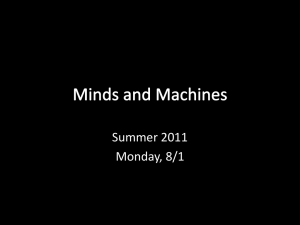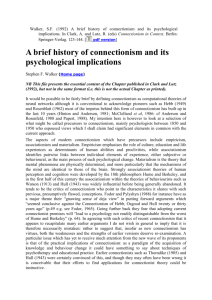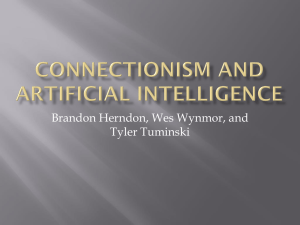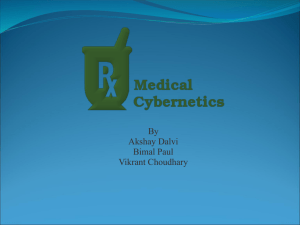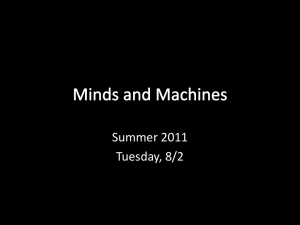Past-tense learning model
advertisement
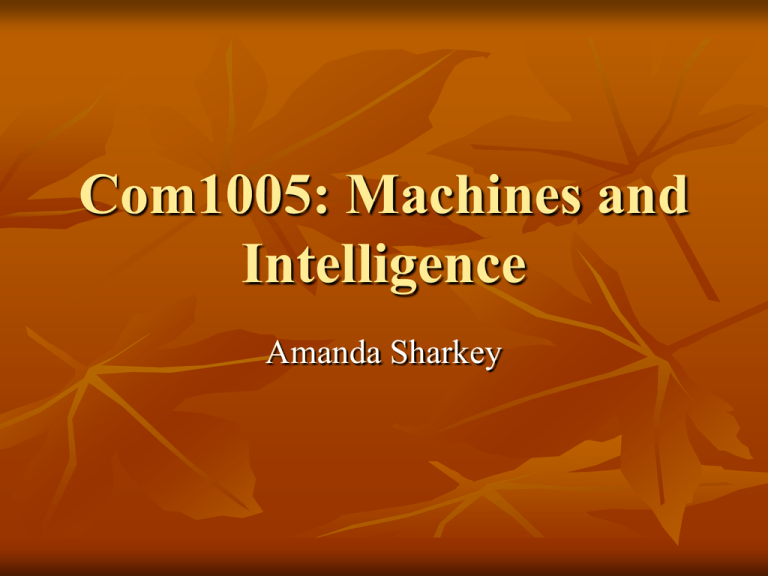
Com1005: Machines and Intelligence Amanda Sharkey Summary Brain – thought emerging from interconnected neurons Neural computing – based on simplified model of neurons Neurons on/off, modifiable connections between them (learning) Brief history of NNs McCulloch and Pitts neurons, and Perceptrons Minksy and Papert point out limitations Traditional Symbolic AI Resurgence of Connectionism – Examples – Backpropogation and MLPs Pattern recognition and Pandemonium NetTalk Past-tense learning model Differences between Symbolic AI and Connectionism Which is better? Past-tense learning model A model of human ability to learn past-tenses of verbs Presented by Rumelhart and McClelland (1986). Past-tenses? Today I look at you, yesterday I ? at you. Today I speak to you, yesterday I ? to you. Today I wave at you, yesterday you ? at me. rick – yesterday he ? the sheep Many regular examples: E.g walk -> walked, look -> looked Many irregular examples: E.g. bring -> brought, sing -> sang Children learning to speak Baby: DaDa Toddler: Daddy Very young child: Daddy home! Slightly older child: Daddy came home! Older child: Daddy comed home! Even older child: Daddy came home! Stages of acquisition Stage 1 Past tense of a few specific verbs, some regular e.g. looked, needed Most irregular e.g. came, got, went, took, gave As if learned by rote (memorised) Stage 2 Evidence of general rule for past-tense – add ed to stem of verb E.g. camed or comed Also for past-tense of nonsense word e.g rick They added ed - ricked Stage 3 Correct forms for both regular and irregular verbs Verb type Stage 1 Stage 2 Stage 3 Early verbs correct Regularised correct regular correct correct Other irregular novel regularised Correct or regularised regularised Regularised U shaped curve – correct form in stage 1, errors in stage 2, few errors in stage 3. Suggests rule acquired in stage 2, and exceptions learned in stage 3. Rumelhart and McClelland – aim to demonstrate that connectionist network would show same stages and learning patterns. Trained net by presenting Input – root form of word e.g. walk Output – phonological structure of correct past-tense version of word e.g. walked Test model by presenting root form as input, and see what past-tense form it generates as output. Used Wickelfeature method to encode words Wickelphone: Target phoneme and context E.g. came #Ka, kAm, aM# Coarse coded onto Wickelfeatures, 16 wickelfeatures for each wickelphone Input and output of net 460 units Shows need for input representation Training: used perceptron convergence procedure (problem linearly separable) Target used to tell output unit what value it should have. If output is 0 and target is 1, need to increase weights from active input units If output is 1 and target is 0, need to reduce weights from active units. 560 verbs divided into High, Medium, and Low frequency (regular and irregular) 1. Train on 10 high frequency verbs for 10 epochs 2. 410 medium frequency verbs added, trained for 190 more epochs Live-lived, look-looked, come-came, get-got, give-gave, make-made, take-took, go-went, have-had, feel-felt Net showed dip in performance – making errors like children e.g come -comed 3. Tested on 86 low frequency verbs not used for training Got 92% regular verbs right, 84% irregular right. Model illustrates: Neural net training – repeated examples of inputoutput pairs Generalisation – correct outputs produced for untrained words E.g. input guard -> guarded Input cling -> clung Past-tense model: Showed - a neural net could be used to model an aspect of human learning - same u-shaped curve shown as found in children. - the neural net discovered the relationship between inputs and outputs, not programmed. - that it is possible to capture apparently rulegoverned behaviour in a neural net. Strengths of connectionism Help in understanding how a mind, and thought, emerges from the brain Better account of how we learn something like past-tense, than explicit programming of a rule? Is this a good model of how we learn past-tenses? Fierce criticisms: Steve Pinker and Alan Prince (1988) More than 150 journal articles followed on the debate Net can only produce past-tense forms, cannot recognise them. Model presents pairs of verb+past tense, children don’t get this. Model only looks at past-tense, not the rest of language Getting similar performance to children was the result of decisions made about: Training algorithm Number of hidden units How to represent the task Input and output representation Training examples, and manner of presentation Differences between Connectionism and traditional Symbolic AI Knowledge – represented by weighted connections and activations, not explicit propositions Learning – Artificial Neural Nets (ANNs) trained versus programmed. Also greater emphasis on learning. Emergent behaviour – rule-like behaviour, without explicit rules More Differences Examinability: you can look at a symbolic program to see how it works. Artificial Neural net – consists of numbers representing activations, and weighted links. Black box. Symbols: connectionism has no explicit symbols Relationship to the brain: ‘Brain-style’ computing versus manipulation of symbols. Connectionism versus Symbolic AI Which is better? Which provides a better account of thought? Which is more useful? Artificial neural nets more like the brain than a computer???? Are Brains like Computers? Parallel operation – 100 step argument Neuron slower than flip-flop switches in computers. Takes thousandth of a second to respond, instead of a thousandmillionth of a second. Brain running AI program would take 1000th of a second for each instruction Brain can extract meaning from sentence, or recognise visual pattern in 1/10th of a second. Means program should only be 100 instructions long. But AI programs contain 1000s of instructions Suggests parallel operation Connectionism scores Brains unlike computers Computer memory – exists at specific physical location in hardware. Human memory – distributed E.g. Lashley and search for engram. Trained rats to learn route through maze. Could destroy 10% of brain without loss of memory. Lashley (1950) “there are no special cells reserced for special memories….The same neurons which retain memory traces of one experience must also participate in countless other activities” Connectionism scores Brains unlike computers Graceful degradation When damaged, brain degrades gradually, computers crash. Phineas Gage Railway worker – iron rod through the anterior and middle left lobes of cerebrum, but lived for 13 years – conscious, collected and speaking. Connectionism scores Brains unlike von Neumann machines with: Sequential processor Symbols stored at specific memory locations Access to memory via address Single seat of control, CPU Connectionism and the brain Units in net like neurons Learning in NNs like learning in brain Nets and brains work in parallel Both store information in distributed fashion NNs degrade gracefully – if connections, or some neurons removed, can still produce output. But …. Connectionism only “brain-style” computing Neurons simplified – only one type Learning with backpropagation biologically implausible. Little account of brain geometry and structure Also …. Artificial neural nets are simulated on computers e.g. past-tense network Rumelhart and McClelland simulated neurons, and their connections on a computer. Connectionism and thought Can connectionism provide an account of mind? Symbolicists arguing that only a symbol system can provide an account of cognition Functionalists: Not interested in hardware, only in software Connectionist arguing that you need to explain how thought occurs in the brain. Rule-like behaviour Past tense learning Create rules, and exceptions Or show that rule-like behaviour can result from a neural net, even though no rule is present. Implementational connectionism Eliminative connectionism A different way of implementing symbolic structures, different level of description Radical position, cognition and thought can only be properly described at connectionist level Revisionist connectionism Symbolic and connectionist are both legitimate levels of description. Hybrid approach – choose best level depending on what is being invesigated. Symbolic AI and Connectionism Different strengths Connectionism – good at low level pattern recognition, in domains where there are many examples, and it’s hard to formulate the rule. Symbolic AI – good at conscious planning, reasoning, early stages of learning a skill (rules). Hybrid system Connectionist account of lower level processes Symbolic account of higher level processes. Connectionism and Strong AI Searle – Chinese room shows program does not understand, any more than operator of Chinese room. Problem of symbol grounding ….. But does a neural net understand? It learns….. Chinese Gym – a room full of english speaking people carrying out neural processes, and outputing chinese. Do they understand? Assignment Planning out your argument…. Researching a topic Wikipedia, can be good starting point. Finding journals – see link to electronic holdings on library page. Find recent paper and follow up their references Visit the library! Find relevant book, and look at its references Leave time to read through what you have written, and improve it. Zeigarnik effect Russian psychologist – noticed that waiters only remembered orders until the bill was paid. We go on thinking about something that has not been completed. Ergo – get started on your essay, and you will go on thinking about it. Presentations - Tutorial groups – contact email by Monday week 12. (split groups?) Prepare presentation – week 13-15 in the new year. To be assessed: weeks 1 and 2 of next semester. Each group: 5 – 10 minute presentation. Paper hand in with title and acknowledgements –(who did what ? research, presentation, delivery etc.) Topics: AI in the movies - how accurate is its portrayal? Who has argued for Strong AI, and how convincing are their claims? What was Lady Lovelace's objection to the Turing Test, and is it still valid? AI hype?: Find some startling AI predictions, and consider their likelihood of coming true. Early history of AI Can robots be creative? AI in the news AI and Ethics – should we be concerned?

